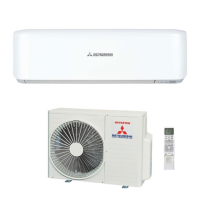
Do you have a question about the Mitsubishi Heavy Industries SRK20ZFX-S and is the answer not in the manual?
| Type | Split System |
|---|---|
| Cooling Capacity | 2.0 kW |
| Heating Capacity | 2.5 kW |
| Power Supply | 220-240V, 50Hz |
| Refrigerant | R32 |
| Outdoor Unit Dimensions (W x H x D) | 780 x 540 x 290 mm |
| Indoor Unit Noise Level (Low) | 21 dB(A) |
| Outdoor Unit Noise Level | 45 dB(A) |
| Energy Efficiency Rating (Cooling) | A+++ |
Key features of the SRK series air-conditioners, including inverter technology and fuzzy control.
Explanation of the model naming convention for the air conditioner units.
Detailed technical specifications for SRK20ZFX-S, 25ZFX-S, 35ZFX-S, and 50ZFX-S models.
Operating limits for indoor/outdoor temperature, piping length, and height difference for models.
Dimensional drawings and specifications for the indoor and outdoor units.
Diagrams illustrating the refrigerant piping system for SRK20ZFX-S, 25ZFX-S, 35ZFX-S, and SRK50ZFX-S models.
Charts and formulas for correcting cooling/heating capacity based on temperature and piping length.
Wiring diagrams for SRK20ZFX-S, 25ZFX-S, 35ZFX-S, and SRK50ZFX-S models.
Explanation of buttons and indicators on the wireless remote control for operation.
How to operate the unit using the physical ON/OFF button when the remote is unavailable.
Description of the auto-restart feature after a power interruption and its settings.
Procedure for modifying circuit boards to prevent wrong operation with multiple remote controls.
How to control the flap and louver swing and memory functions using the remote.
Explanation of the comfortable timer function and its operation start time adjustments.
Details on how the sleep timer controls temperature and operation time.
Description of the 'Clean' operation mode for preventing fungus and odors.
Details on functional components, air flow selection, and operation during heating mode.
Operation of functional components, air flow selection, and control during cooling mode.
Explanation of heating and cooling oriented dehumidifying selection and operation.
How the unit determines operation mode and setting correction value based on temperatures.
Details on the ECONOMY operation mode and its settings for heating and cooling.
Details on various protective controls, including frost prevention, compressor protection, and pressure controls.
Important safety instructions and warnings for installation and operation.
Guidelines for selecting suitable indoor and outdoor unit installation locations and limitations.
Procedures for installing the indoor unit, including mounting, wiring, drain hose, and fixing.
Guidelines for installing the outdoor unit and connecting wiring between units.
Preparation, connection, and insulation procedures for refrigerant piping.
Steps for conducting a test run and checking operation data after installation.
Guidelines for the installation and operational range of the wireless remote control.
Comprehensive troubleshooting steps, including self-diagnosis, error codes, and service mode.
Procedures for evacuation and refrigerant charging during servicing.
General information about R410A refrigerant, its characteristics, and properties.
Safety precautions and necessary tools for handling R410A refrigerant during installation/servicing.
Information on piping materials, joints, processing, brazing, and storage for R410A.
Identification and details of tools exclusive for R410A and general tools required.
Procedures for air purge, gas leakage inspection, and additional refrigerant charging.
Procedures for removing the unit, including refrigerant recovery and disconnection.
Recommendation against reusing existing piping when replacing units, especially between R22 and R410A.
Warning against retrofitting R22 units with R410A refrigerant due to potential malfunction or damage.
Steps for recharging refrigerant when necessary, following specified amounts and procedures.
Procedures and checks for refrigerant recovery equipment, including accessory tools.